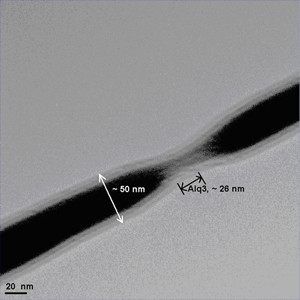
UC and VCU Researchers Team Up to Advance How Computers and Electronics Work
Researchers at the University of Cincinnati and Virginia Commonwealth University (VCU) have made an important advance in the emerging field of spintronics that may one day usher in a new generation of smaller, smarter, faster computers, sensors and other devices, according to findings reported in todays issue of the journal "Nature Nanotechnology."
Electrons have three important features: their mass, their charge and their spin. Electrons are constantly spinning. Spintronics research, then, focuses on using the spin of an electron for storing, processing and communicating information. The spin of an electron is a property that makes the electron act like a tiny magnet. This property can be used to encode information in and enhance performance of electronic circuits, computers and virtually every other electronic gadget. The spin of electrons is what enables magnetic resonance imaging (MRI), for example.
The research team of electrical and computer engineers from the University of Cincinnatis College of Engineering and VCUs School of Engineering examined the spin of electrons in organic nanowires, which are ultra-small structures made from organic materials. These structures have a diameter of 50 nanometers, which is 2,000 times smaller than the width of a human hair.
In order to store and process information, the spin of an electron must be relatively robust, says author Supriyo Bandyopadhyay, a professor in the VCU Department of Electrical and Computer Engineering. The most important property that determines the robustness of spin is the so-called spin-relaxation time, which is the time it takes for the spin to relax. When spin relaxes, the information encoded in it is lost. Therefore, we want the spin-relaxation time to be as long as possible. Typically, the spin-relaxation time in most materials is a few nanoseconds to a few microseconds.
The UC-VCU team is the the first to study spin-relaxation time in organic nanostructures and found that it can be as long as a second. This is at least 1,000 times longer than what has been reported in any other system. The team fabricated their nanostructures from organic molecules (which contain carbon and hydrogen atoms). In these materials, spin tends to remain relatively isolated from perturbations that cause it to relax. That makes the spin-relaxation time very long.
The team was also able to pin down the primary spin-relaxation mechanism in organic materials, which was not previously known. Specifically, they found that the principal spin-relaxation mechanism is one where the spin relaxes when the electron collides with another electron, or any other obstacle it encounters when moving through the organic material. This knowledge can allow researchers to find means to make the spin-relaxation time even longer.
The organic spin valves we developed are based on self-assembled structures grown on flexible substrates, which could have a tremendous impact of the rapidly developing field of plastic electronics, such as flexible panel displays, says Marc Cahay, a professor in the UC Department of Electrical and Computer Engineering. If the organic compounds can be replaced by biomaterials, this would also open news areas of research for biomedical and bioengineering applications, such as ultra-sensitive sensors for early detection of various diseases.
The fact that the spin-relaxation time in organic materials is exceptionally long makes them the ideal host materials for spintronic devices. Organic materials are also inexpensive, and therefore very desirable for making electronic devices.
The VCU-Cincinnati research advances nanotechnology, which is a rapidly growing field where engineers are developing techniques to create technical tools small enough to work at the atomic level. Also, by using nanoscale components, researchers have the ability to pack a large number of devices within a very small area. The devices themselves are just billionths of a meter; and trillions of them can be packed into an area the size of a postage stamp. Furthermore, they consume very little energy when they process data.
These are very exciting times to form interdisciplinary research teams and bring back the excitement about science and engineering in students at a very young age to raise them to become the future generations of nanopioneers, Cahay adds.
UC is growing a large reputation about tiny structures. Researchers at UC are reaching new heights in growing record-breaking carbon nanotubes. The Department of Electrical and Computer Engineering hosted Nano 2006, the sixth national IEEE Conference on Nanotechnology in July 2006. The University of Cincinnati was also one of the first in the country to offer nano to undergraduates, and was ranked #2 in the nation in undergraduate nanoeducation by Small Times magazine.
The work is supported by the U.S. Air Force Office of Scientific Research and the National Science Foundation.
Related Stories
Mayor Pureval, Rob Richardson lead ethical AI symposium
July 5, 2024
As artificial intelligence rapidly integrates into everyday life, Rob Richardson, CEO and founder of Disrupt Now and MidwestCon and local tech startup partner of the University of Cincinnati 1819 Innovation Hub, recently spearheaded the Responsible AI Symposium with Cincinnati Mayor Aftab Pureval, calling upon community leaders to discuss and ensure artificial intelligence technologies help users rather than harm.
UC’s microchip training includes innovative VR
July 2, 2024
To build a virtual microchip factory, University of Cincinnati doctoral students turned to the real one where they work. UC launched a new training program for microchip manufacturing in advance of the new fabrication plant Intel Corp. is opening in Ohio.
UC grad’s innovative tech to manage ER wait times
June 25, 2024
When launching Teravus, a health care triage management startup, Jason Murray turned to the University of Cincinnati's Center for Entrepreneurship and the 1819 Venture Lab for guidance and funding.
